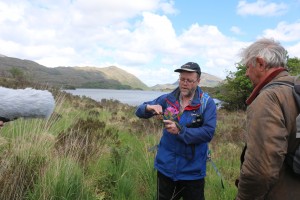Killarney’s Biodiversity succeeds in delighting Wildlife Enthusiasts

May 24th, 2016
There are few places as beautiful at this time of year as Killarney National Park. Wildflowers are in bloom, birds sing from trees at every turn, and resident mammals are out in force. A lucky group of competition winners last weekend enjoyed a wildlife-filled tour of the 26,000 acre park as part of Biodiversity Week.
Over Saturday and Sunday, which was International Day for Biological Diversity, the 9 lucky winners were put through their paces with two day-treks, a boat ride from Ross Castle up through the Killarney Lakes to the Upper lake, and a nocturnal walk looking for badgers, bats and other nocturnal animals.
Guided by Chris Barron and Tara Buckley from Killarney National Park Education Centre, attendees were given countless illustrations of the unique ways in which flora and fauna of all forms have evolved and adapted to live in this place and the complex webs of life that it supports. For example, the 400 acres of wet woodland, a rare habitat comprised of various types of Willow and nitrogen-fixing Alder, provides perfect swampy conditions for plants like Meadowsweet and Water Mint as well as insects such as Water beetles . These insects, in turn, draw waterfowl and bats, which can roost in hollowed-out rotting trees. During deer’s rutting season, stags also use wallow-holes in the wet woodland to cover themselves in mud to increase their size and put on an impressive show for curious doe.
Another unique habitat in the national park is the 60 acre Yew woodland known as Reenadinna wood, and the largest and best intact of only three pure Yew woodlands in Europe. Precariously rooted on a bed of limestone, this woodland is listed as Annex 1 under the EU Habitats directive for its importance in nature conservation, most notably sustaining bryophytes such as the numerous types of mosses that cover the forest floor, making the woodland look like a scene out of Lord of the Rings. There is evidence from a local pollen core that Yew has dominated this site for the past 5,000 years – so while the trees may be described as a few centuries old, the woodland habitat is much, much older.
Despite most parts of the tree being poisonous, non-native species such as Sika deer have been known to eat the bark, possibly in an attempt to treat intestinal bugs. Native pine martens which were successfully reintroduced to the park, are generalist feeders, benefiting from the heavy yew berry crop each year.
Despite these cases of ecosystem harmony, however, many species in the park are threatened by habitat loss and the impact of invasive species, the most notorious of which is the Common Rhododendron (Rhododendron Ponticum). Introduced in the 1850’s as an ornamental plant, this evergreen bush prevents light from reaching plants on the forest floor, affecting 2/3 of the oak woodland, and impeding its ability to regenerate. A removal programme is ongoing, which consists of uprooting younger plants and suspending them from trees to wither away, as well as injecting Glyphosate directly into the trunks and stumps of mature plants, to reduce the impact of this controversial herbacide on the surrounding environment. However, Common Rhododendron spreads prolifically, with between 3000-7000 seeds released by one flower head, and the park has been an uphill struggle.
The Sika Deer also poses ecological threats in the park, as they overgraze the forest floor and, were they to interbreed with the Red Deer, they could compromise the genetic integrity of Ireland’s only intact native herd which dates from the Neolithic period. Of concern also, is the fact that last winter was the first time that Greenland White-fronted Geese were not recorded wintering on the blanket bog between Lord Brandon’s Cottage and Derrycunihy Wood. This fact that may also be linked to the presence of Sika Deer, who flush the geese as they follow them in pursuit of their highly nutritious droppings.
The National Park represents a microcosm of the state of nature conservation in general: while our visitors got to see spectacular species like the Sea Eagle (from a safe distance by boat), the insect-eating Butterwort plant and hear the Lesser Horseshoe Bat, the challenges facing the biodiversity of the park due to human intervention are all too plain to see.
One positive development in recent years has been the introduction of nappies to the Jarvey horses. The initiative has been of immense benefit to the park ecosystem. Prior to the introduction of these dung catchers, the horses had essentially been freely fertilising the woodlands, grasslands and lakes of the park. While fertilisers are useful for farmers and gardeners, in the context of semi-natural habitats, the nitrogen and phosphate content of dung is essentially a major pollutant. It seriously affects the nutrient balance in these habitats, making them more suitable for aggressive and common species like nettle and bramble (and contributing to algal blooms in the lakes) and rendering the habitats unsuitable for the more natural characteristic species that are found in better quality wild habitats.
[x_author title=”About the Author”]










